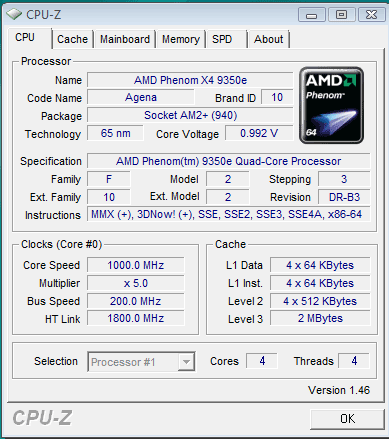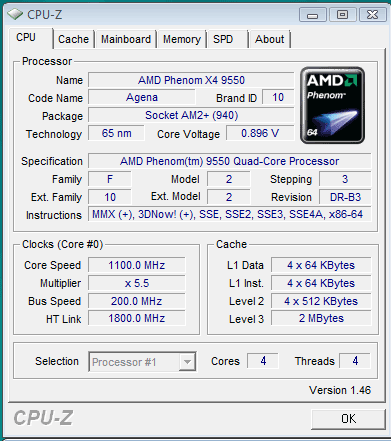AMD's Phenom X4 9950, 9350e and 9150e: Lower Prices, Voltage Tricks and Strange Behavior
by Anand Lal Shimpi & Gary Key on July 1, 2008 12:00 AM EST- Posted in
- CPUs
Making Your Own 9350e
One of the most interesting aspects of testing the new 9350e was figuring out if the new 65W TDP rating held any true advantages over the existing 95W TDP Phenom X4 product line. Does the 9350e hold an advantage in power consumption? It depends on how you look at the situation. Yes, compared to the 9550 X4 the 9350e X4 holds a 8% advantage at idle, 7% advantage in H.264 playback, and 13% advantage in gaming. Sounds impressive and certainly makes for good marketing materials, especially when describing the "Green" benefits of this new processor.
| Idle | H.264 Playback | Company of Heroes | |
| AMD Phenom X4 9550 | 72.2W | 88.1W | 102.8W |
| AMD Phenom X4 9350e | 66.8W | 81.8W | 89.2W |
However, let's take a look at the other side of the coin. First off, those benefits come at the expense of 200MHz in processor speed or a 10% lower core clock setting with an 11% increase in processor cost. Admittly, on our IGP platforms, this decrease in core clock speed is not noticeable in gaming as we are GPU limited for the most part. In video/audio encoding operations and general office applications the speed decrease is not apparent in day to day operations. The increase in cost could be excused over time based on theoritical power savings. That brings us to our Mr. Science experiment of the day. What if we could have our cake and eat it too, or in simple terms can we keep the 200MHz speed increase afforded by the 9550 while retaining the power savings of the 9350e at a 11% cost savings? Today is our lucky day as it is quite easy to accomplish this task, well almost.
Our first task was to compare the 9350e to the 9550 at stock settings. As mentioned above, the power consumption savings were measurable and significant in some areas. We then set our 9550 to mimic the 9350e at the standard 2.0GHz (10x200) setting. Our actual voltage of .896V on the 9550 is slightly lower than the .992V reported by the 9350e. However, the idle wattage is .6W higher. A reading that was consistent through hours of testing on various boards, so whether it is in the processor or CnQ settings, the 9350e does hold the slightest of advantages. This advantage disappears in our H.264 and gaming tests where the "9550e" holds a minimum advantage. So, on a clock for clock basis, the two CPUs are almost identical in power consumption and offline benchmarking showed no differences in performance. In other words, a B3 Phenom is a B3 Phenom no matter how you designate the part number.
| Idle | H.264 Playback | Company of Heroes | |
| AMD Phenom X4 9550 | 72.2W | 88.1W | 102.8W |
| AMD Phenom X4 9550 @ 2.2GHz/0.944V | 68.7W | 82.9W | 89.7W |
| AMD Phenom X4 9550 @ 2.0GHz/0.896V | 67.4W | 81.4W | 88.7W |
| AMD Phenom X4 9350e | 66.8W | 81.8W | 89.2W |
In our second test, we decided to see how low we could set the voltage on the 9550 and retain the native 2.2GHz clock speed (11x200). We set the voltage to 1.125V in the BIOS that resulted in a operating value of .944V with CnQ enabled. This setting allowed us to complete our entire benchmark test suite (PC Vantage, games, audio/video apps, Prime95, etc.) without issue. The idle number is 2% higher, H.264 playback is up 1% and gaming is increased less than a half percent. In other words, we can experience a 10% improvement in clock speeds with a 10% decrease in cost while retaining almost identical power consumption numbers. Every CPU will be different, some better, some worse, but overall we do not see a compelling reason for purchasing the 9350e if you have the time/knowledge to spend a few minutes in the BIOS and running a couple of stability tests.
On a side note, we could not replicate our voltage settings with CnQ turned off. If we set the same operating voltages in the BIOS, the systems would not POST and if they did, we were lucky if the system booted into Vista which usually lead to an immediate BSOD. On average, we had to set the 9350e to 1.150V to ensure 24/7 stability and the 9550 to 1.175V. In fact, NB voltage had to be increased from 1.10V to 1.15V to pass the PC Vantage and Crysis benchmarks.













36 Comments
View All Comments
Gikaseixas - Wednesday, July 2, 2008 - link
Other sites tested it already and could hit 3.2 - 3.6 speeds. Hopefully Anandtech will be able to overclock a Phenom to it's limits this time around.Googer - Wednesday, July 2, 2008 - link
Missing from the benchmarks is the Intel Core 2 Quad Q9550 Yorkfield 2.83GHz 12MB. How would this chip stack up against all others tested?http://www.newegg.com/Product/Product.aspx?Item=N8...">http://www.newegg.com/Product/Product.aspx?Item=N8...
RamarC - Wednesday, July 2, 2008 - link
the q9550 isn't in the same price range as the other processors so that's why it wasn't included. as for performance, either subtract or add 10% to the q9450's figures.DanD85 - Wednesday, July 2, 2008 - link
Are you absolutely sure about that? As hothardware thinks differently:"By altering its multiplier and increasing the CPU voltage to 1.45v, we were able to take our Phenom X4 9950 to an respectable 3.1GHz using nothing but a stock AMD PIB cooler. Higher frequencies were possible, but we couldn't keep the system 100% stable, so we backed things down to 3.1GHz. While running at that speed, we re-ran some tests and also monitored core temperatures and found that the chip never broke the 60ºC mark, and hovered around 58ºC under load - at least according to AMD's Overdrive software. That is one heck of an overclock and relatively cool temperatures for a Phenom in our opinion. If the majority of chips have the same amount of headroom as ours, we suspect the 9950 Black Edition will be appealing to AMD CPU enthusiasts looking for the best the company has to offer."
http://www.hothardware.com/Articles/AMD_Phenom_X4_...">http://www.hothardware.com/Articles/AMD...nom_X4_9...
KaarlisK - Wednesday, July 2, 2008 - link
Maybe by setting affinity for Photoshop's threads to a certain core, it would be possible to verify whether Vista's thread management is part of the cause?Zoomer - Wednesday, July 2, 2008 - link
I know its a novel concept, but what about running some benches in XP to see if it's another Vista issue?Rhoxed - Wednesday, July 2, 2008 - link
Increasing the NB core (IMC) clock (in Phenom it runs async from the Core Speed unlike Athlon which is Sync) drops latencies (especially L3) and increases memory performance/throughput, which in turn improves system performance. The Phenom starts to come to life when you hit a 2.6GHz core speed with a NB core clock at 2200MHz+. Depending on the application and CPU, increasing NB core speeds (getting up to 2200MHz+) can result in performance differences from 3%~12% in most cases.Upping my NB/HT to 2400MHz over the stock 2000 at the same clockspeed (2800) i net a 15%~ increase (on a 9850BE)
RamarC - Tuesday, July 1, 2008 - link
i'm a developer and want to upgrade my win2k3/ss2k5 server to a quad core. since it currently has a 3.4ghz p4d, a phenom 9x50 would be a big step-up (even though i don't have any performance issues). but the p4d has been very reliable and i don't want to have to deal with flaky hardware issues when i'm pushing code out the door. should i just bite the bullet and shell out the extra cash for a p45+q9450?Calin - Wednesday, July 2, 2008 - link
I have an AMD based PC at home, and I look forward to another AMD-based pc (780G and Phenom X3 or X4).These being said, I think for a server you really really should go for an Intel configuration. Also, at 3.4 GHz a P4D probably is one hell of a power draw.
Compared to your current server, and based on what I think you need, I don't think a quad core would help you - a dual core would probably be enough, and Intel has those aplenty.
Zoomer - Wednesday, July 2, 2008 - link
From the article, it seems like sticking to the cheaper, sub 100W TDP cpus and not overclocking is the way to go.